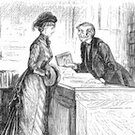Title: The Mill Wheel
Author and Title: Helen Dickens. The Mill Wheel: A Novel
First Edition: London: T. C. Newby, 1874. 3 volumes.
Summary: The novel follows the life of Renie Dorothy Rudkin, the niece of the baronet Sir Bevin Rudkin of Zeigleheath on the coast of Sussex. Renie's mother died after giving birth; Renie's father Colonel Denis Rudkin leaves home in despair to serve as a colonial governor leaving his daughters to the care of a governess and his brother. He returns home after nine years and shortly thereafter dies leaving his daughters almost nothing. Renie's eldest sister Adeline marries a neighbor and Renie is sent to boarding school where she cultivates her talents in art. To everyone's surprise, the elderly Sir Bevin marries the twenty-year-old Esther, the penniless daughter of a Methodist minister, after meeting her in Brighton. Out of guilt at his neglect of his brother's children, Sir Bevin offers a home to the seventeen-year-old Renie. At Zeigleheath, Renie paints in secret, sending her canvases to an acquaintance who sells them for her anonymously. (One of her paintings, unknown to her, makes its way to the Royal Academy.) Renie cultivates a polite distance between Lady Rudkin and her maid Shepperton but becomes a great favorite of her infant cousin, Rodney, the new heir to Zeigleheath. The arrival of her school friend Lucy Northwood and the Spanish painter Rufus Sebastian ends Renie's loneliness: Rufus discovers Renie's ability to paint and the two work together painting portraits of the family. Rufus tells his story to Renie and Lucy: his mother left him at a young age at a Spanish monastery where he remained until age thirteen. Unceremoniously exited from the monastery, Rufus made his way in the world as an wandering painter eventually making his way to England. Lucy, meantime, falls in love with neighboring German count. A visit from Leopold Gunstan stirs the plot: a distant relation of Sir Bevin, he stood to inherit the estate before the birth of Rodney. Without a profession or much money, the oily Gunstan has spent his life traveling. Lucy, playing detective, immediately suspects a prior connection between Gunstan and Lady Rudkin. One night, Sir Bevin dies suddenly at his desk. His will names Renie as the sole guardian of his son (which he had arranged shortly before his death) and gives Lady Rudkin only the baronet's insurance. Renie, in her first duty, immediately orders Gunstan away. Within a year, Lady Rudkin has left after an argument between Renie and Shepperton. Shortly afterwards, Rodney dies after falling in the river and drowning. Gunstan, now Sir Leopold, inherits the estate and only after months of searching can he be found. He arrives to take over the estate with his new wife, Esther, formerly Lady Rudkin, now Lady Gunstan. Renie moves to a house nearby. Some Spanish gypsies take up residence on the estate and Renie is called to deathbed of their "queen" who turns out to be the missing sister of Sir Bevin. Presumed dead, she as a young woman instead ran off with the gypsies. Renie concludes (rightly) that the woman is the mother of Rufus—hence, he would be the true owner of Zeigleheath. Renie vows not to tell Rufus of his parentage before her aunt dies. Ultimately, through the testimony of a servant and a gypsy girl, it is revealed that Sir Bevin committed suicide after seeing his wife kiss Gunstan. Gunstan hid the death in order to secure Lady Rudkin's insurance benefit. Confronted by the witnesses, Gunstan confesses to the cover-up and to his murder of Rodney before killing himself. The novel ends with Rufus's return—ill, he dies shortly after. The estate reverts to the crown. The novel clearly draws on Braddon's Lady Audley's Secret. (TJB)
Title Tags:
References: BL; Sadleir
Texts
- Search for title at The Online Books Page (please note: the search will take you out of At the Circulating Library)
